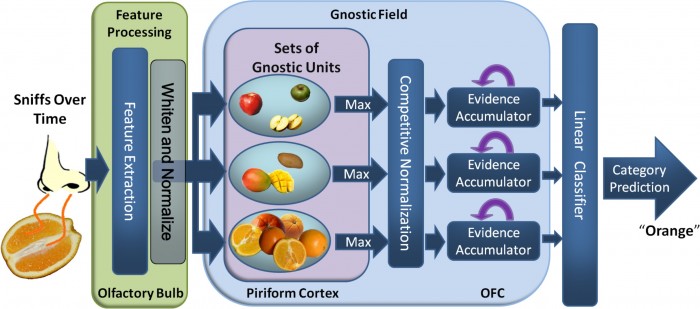Gnostic Fields
A Gnostic Field is a brain-inspired classification algorithm based on the ideas of the neuroscientist Jerzy Konorski. I turned Konorski’s theory into an algorithm. For images, Gnostic Fields achieve state-of-the-art accuracy at classifying birds, dogs, and general objects using off-the-shelf computer vision features (Color SIFT). It also achieves state-of-the-art accuracy on music classification and on classifying odors using an electronic nose. Gnostic Fields are easy to implement, fast to run, and don’t require an enormous amount of training data to get good results. Because of these properties, I believe Gnostic Fields should be one of the first classifiers a person should try for recognizing images, sounds, and similar data.
In Kanan (2013), I presented my first implementation of Gnostic Fields, and it surpassed the best algorithms for classifying general objects (Caltech-256), electronic nose data (108 odors), and musical artists (Artist 20). Shortly after this project, I developed a space-variant active vision system that used a Gnostic Field to accumulate information across simulated eye movements.
In Kanan (2014), I developed an improved version of the algorithm that can scale to larger datasets. I tested the model on fine-grained image classification problems (CUB-200 and Stanford Dogs), and once again Gnostic Fields achieved the state-of-the-art, even though Gnostic Fields are simpler and used only a single feature type at a single scale.
Konorski hypothesized the existence of Gnostic Fields in the human brain, which he thought would facilitate classification of mutually-exclusive categories. A Gnostic Field contains one gnostic set per category, and each gnostic set contains units devoted to matching category-specific patterns. A gnostic set can be thought of as class-specific dictionary, so if a Gnostic Field is trained to distinguish among the six canonical emotional facial expressions, then it would have six gnostic sets. In this scenario, additional Gnostic Fields would be required for other kinds of face processing, such as identifying people.

A hypothetical Gnostic Field for distinguishing among apples, mangoes, and oranges. As a sniff is processed during a time-step, only a few units in the non-orange gnostic sets are active, but many units in the gnostic set for recognizing oranges are active. A Gnostic Field then accumulates evidence across time (or space for images).